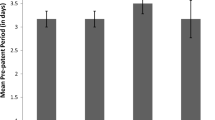Abstract
Ten parasite-free lambs were drenched with oxfendazole on days 0 and 28 and, one day after each drench, were injected with human erythrocytes and ovalbumin. Ten other antigen-injected lambs were not drenched (controls). Lymphocytes collected 3 days after each antigen injection and cultured in RPMI 1640 plus 5% fetal calf serum (FCS) and lymphocytes collected 3 days after the first and 3 and 7 days after the second antigen injection and cultured in 50% autologous serum had decreased blastogenic activity compared with control lymphocytes. After the second drench, decreased blastogenesis was seen with lymphocytes collected on days 3 and 7 and cultured in 5% FCS and concanavalin A (Con A) and on day 3 when cultured in 5% FCS and phytohaemagglutinin (PHA). Decreased blastogenesis was also seen with lymphocytes collected 7 and 29 days after the second injection of antigen and cultured in 50% autologous serum plus Con A and on days 3, 7 and 29 when cultured in 50% autologous serum and PHA.
Significantly depressed antibody responses to both antigens were seen after the second drench. The serum complement level was depressed 3 days after the second injection of antigen. Serum nitric oxide levels were significantly depressed 3 and 21 days after the first and 7 and 21 days after the second injection of antigen. There were no differences in levels of growth-promoting hormones but the drenched lambs gained significantly more weight than the controls.
Similar content being viewed by others
Abbreviations
- C′:
-
complement
- Con A:
-
concanavalin A
- cpm:
-
counts per minute
- EIA:
-
enzyme immunoassay
- FCS:
-
fetal calf serum
- IGF:
-
insulin-like growth factor
- oIGF-1:
-
ovine insulin-like growth factor-1
- PBS:
-
phosphate-buffered saline
- PHA:
-
phytohaemagglutinin
References
Ali, D.N. and Chick, B.F., 1992. Effect of feed type on the pharmacokinetic disposition of oxfendazole in sheep.Research in Veterinary Science,52, 382–383
Aumann, J., 1992. Effects of colchicine on mobility and chemoreception ofHeterodera schachtii (Nematoda: Heteroderidae) males.International Journal for Parasitology,22, 87–90
Bogan, J.A. and Marriner, S., 1980. The analysis of benzimidazoles in body fluids by high performance liquid chromatography.Journal of Pharmaceutical Sciences,69, 422–423
Borgsteede, F.H.M., de Leeuw, W.A. and van den Burg, W.P.J., 1988. A comparison of the efficacy of four different long-acting boluses to prevent infections withDictyocaulus viviparus in calves.Veterinary Quarterly,10, 177–186
Campbell, W.C., 1990. Benzimidazoles: veterinary uses.Parasitology Today,6, 130–133
Downey, N.E., 1988. Effect of treatment of first season calves with an OPRB on their immunity to lungworm in the second season.Veterinary Record,123, 571–572
Dustin, P., 1984.Microtubules, (Springer-Verlag, New York)
Eysker, M. and Boersema, J.H., 1989. Delay in timing of the oxfendazole pulse release bolus in calves in the Netherlands.Veterinary Quarterly,11, 210–215
Eysker, M., Boersema, J.H. and Kooyman, F.N.J., 1990. Immunity of calves treated with an oxfendazole pulse release bolus to challenge withDictyocaulus viviparus.Research in Veterinary Science,48, 301–305
Gluckman, P.D., Mueller, P.L., Kaplan, S.L., Rudolph, A.M., Grumback, M.M., 1979. Hormone ontogeny in the ovine fetus. I. Circulating growth hormone in mid and late gestation.Endocrinology,104, 162–169
Gottschall, D.W., Theodorides, V.J. and Wang, R., 1990. The metabolism of benzimidazole anthelmintics.Parasitology Today,6, 115–124
Green, L.C., Wagner, D.A., Glogowski, J., Skipper, P.L., Wisnok, J.S. and Tannenbaum, G.R., 1982. Analysis of nitrate, nitrite, and [15N]nitrate in biological fluids.Analytical Biochemistry,126, 131–138
Jacobs, D.E., Pitt, S.R., Foster, J. and Fox, M.T., 1987. Interactions between chemoprophylaxis and immunity to bovine parasitic gastroenteritis and bronchitis: pilot studies using an oxfendazole pulse release bolus.Research in Veterinary Science,43, 273–275
Jonas, W. and Stankiewicz, M., 1981. Haemolytic activity of sheep complement for two assay systems.Veterinary Immunology and Immunopathology,2, 393–400
Lacey, E., 1988. The role of the cytoskeletal protein, tubulin, in the mode of action and mechanism of drug resistance to benzimidazoles.International Journal for Parasitology,18, 885–936
Lacey, E., 1989. Comparative biochemistry of parasites and its role in drug resistance — an investigation of species differences in tubulin. In: E.M. Bennett, C. Behm and C. Bryant (eds),Comparative Biochemistry and Parasitic Helminths, (Chapman and Hall, London), 145–167
Lapteva, L.A., 1988. Study of the mitotic activity of somatic cell populations in the bone marrow of rats under the influence of benzimidazole derivatives.Byulleten' Vsesoyuznogo Instituta Gel'mintologii im. K.I. Skryabina,49, 32–34 (in Russian)
Lehr, K.H. and Damm, P., 1986. Simultaneous determination of fenbendazole and its two metabolites in plasma by high performance liquid chromatography.Journal of Chromatography, Biomedical Applications,382, 355–360
Marriner, S.E. and Bogan, J.A., 1981. Pharmacokinetics of oxfendazole in sheep.American Journal of Veterinary Research,42, 1143–1145
Moore, L.G. and Mylek, M.E., 1993. A novel method for the extraction of sheep insulin-like growth factors-I and II from plasma prior to radioimmunoassay.Endocrinology,137, 239–245
Russell, G.J. and Lacey, E., 1991. Temperature dependent binding of mebendazole to tubulin in benzimidazole-susceptible and -resistant strains ofTrichostrongylus colubriformis andCaenorhabditis elegans.International Journal for Parasitology,21, 927–934
Sangster, N.C., Rickard, J.M., Hennessy, D.R., Steel, J.W. and Collins, G.H., 1991. Disposition of oxfendazole in goats and efficacy compared with sheep.Research in Veterinary Science,51, 258–263
Vercruysse, J., Dorny, P., Berghen, P. and Frankena, K., 1987. Use of an oxfendazole pulse release bolus in the control of parasitic gastroenteritis and parasitic bronchitis in first-season grazing calves.Veterinary Record,121, 297–300
Author information
Authors and Affiliations
Rights and permissions
About this article
Cite this article
Stankiewicz, M., Cabaj, W., Jonas, W.E. et al. Oxfendazole treatment of non-parasitized lambs and its effect on the immune system. Vet Res Commun 18, 7–18 (1994). https://doi.org/10.1007/BF01839256
Accepted:
Issue Date:
DOI: https://doi.org/10.1007/BF01839256



